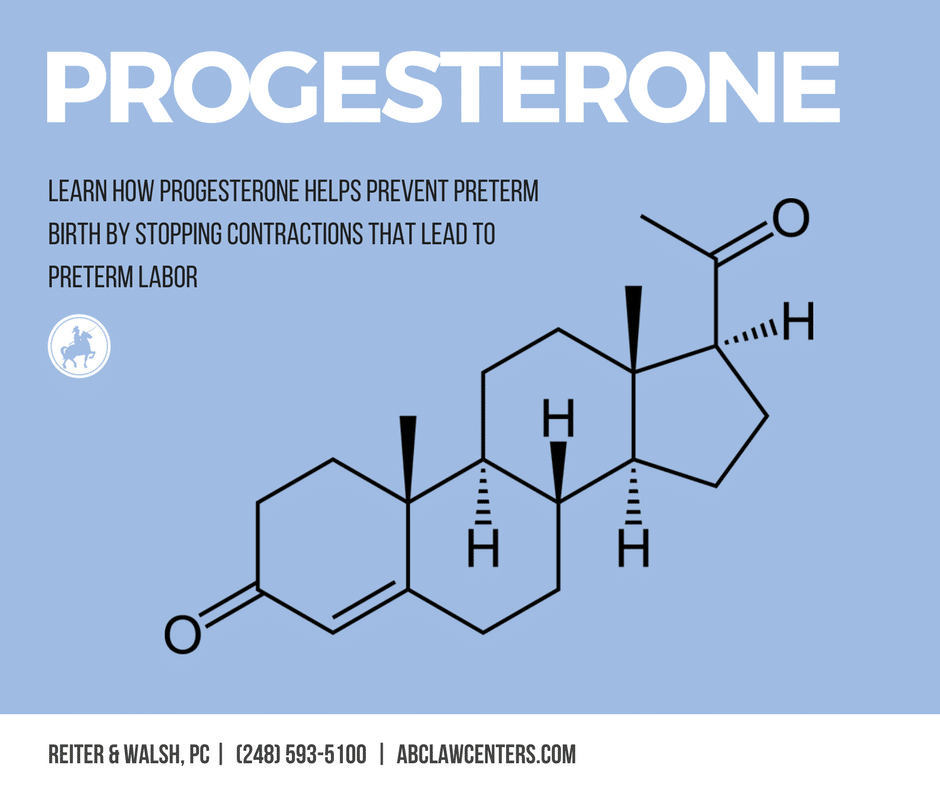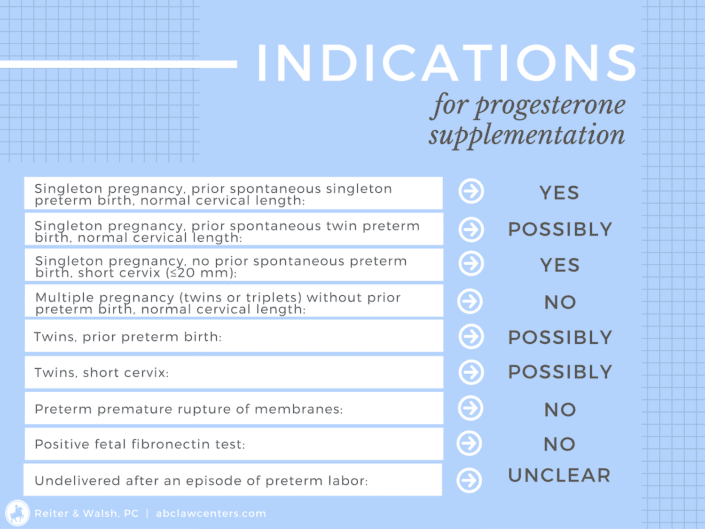Progesterone Hormone Therapy to Prevent Premature Birth & Birth Injuries
Progesterone therapy helps prevent preterm birth by stopping contractions that lead to preterm labor. This provides the baby with additional time to develop in the intrauterine environment.
By helping the baby get as close as possible to full-term, the conditions associated with preterm birth can be avoided or minimized.
Role of Progesterone Hormone in a Healthy Pregnancy
Progesterone is a hormone that is naturally produced by a woman’s body to help her become and remain pregnant. It is produced in the ovaries, and thickens the uterine lining after each ovulation in preparation for a potential pregnancy. If no eggs are fertilized, the level of progesterone drops, and the menstrual cycle begins again. On the other hand, if a fertilized egg implants in the uterine wall, the level of progesterone remains high.
In pregnant women, progesterone helps to keep the uterine lining thick enough to protect the growing fetus. In later pregnancy, progesterone helps the breasts get ready to create milk for the baby, and it helps the lungs work harder to provide oxygen for the baby. Progesterone also prevents premature uterine contractions from occurring. In non-pregnant women, contractions occur monthly during menstruation (they are often recognized as menstrual cramps). A drop in progesterone level is one of the steps that facilitates labor.
Insufficient Progesterone and Preterm Birth
The hormone progesterone is critically important to pregnancy success. If a woman’s body does not produce enough progesterone during her pregnancy, this can result in preterm birth or miscarriage.
Babies born prematurely, or before reaching 39 weeks of gestational age, may be at risk for birth injuries due to a number of issues they suffer because of decreased oxygen to the brain. First of all, premature babies have underdeveloped livers, kidneys, lungs, and immune systems. In addition, the baby’s blood vessels are more fragile. This makes premature babies who suffer oxygen deprivation more prone to brain bleeds, high bilirubin levels, infection, and birth trauma , all of which can cause brain damage. Premature babies are especially vulnerable to this damage.
When a baby is delivered early, there are associated conditions, such as overventilation injuries, that increase the risk of HIE and cerebral palsy. For these reasons, it is crucial that physicians follow standards of care that apply to premature infants, and that they prevent or quickly diagnose and treat conditions that are associated with premature birth.
Progesterone Shots During Pregnancy: Preventing Premature Birth
In 2011, the Food and Drug Administration (FDA) approved intramuscular progesterone (also known as ‘progesterone shots,’‘progesterone therapy,’ or the ‘17p shot’) as a treatment to reduce the risk of preterm birth in women who had previously experienced a spontaneous preterm delivery. This was the first time the FDA ever approved a medication for the prevention of premature birth, and it was the first time in 15 years that a medication had been approved specifically for pregnant women.
There are different types of progesterone treatments depending on the reason the mother is at risk for preterm labor. These include:
- Progesterone shots
- Creams
- Vaginal suppositories
When Do Pregnant Women Receive Progesterone Therapy?
Women who are at risk for preterm birth or miscarriage may be candidates for progesterone therapy. The following are a few examples of circumstances under which a woman might be prescribed progesterone.

Progesterone Because of Past Preterm Birth
When physicians suspect that a mother may have preterm labor because she experienced preterm birth (birth of a single baby or twins) in the past, progesterone therapy is usually started around 16 – 20 weeks of pregnancy, continuing into the 36th week. For this type of progesterone treatment, progesterone 17-alpha-hydroxyprogesterone caproate (progesterone 17 P) is given to the mother every week by injecting it into a muscle. The dosage is typically 250 mg.
Some experts recommend using this therapy if the mother is pregnant with twins and had a premature birth in the past.
Progesterone Because of Short Cervix
Short cervix is a type of “incompetent” or “insufficient” cervix. An abnormally short cervix may open too early in pregnancy, and it is the biggest risk factor for premature birth. It is therefore recommended that all pregnant women have their cervices measured between weeks 19 and 24 of pregnancy. If a pregnant woman has a history of premature birth, the physician should begin carefully monitoring her cervical length with ultrasounds every 2 weeks, from week 15 through week 24 – 26 of pregnancy. Risk factors for a short cervix include the following:
- D & C procedures (surgeries that scrape the uterine lining)
- Diagnosis of cervical incompetence in a previous pregnancy
- Previous preterm premature rupture of membranes (PPROM)
- A biopsy of the cervix used to remove pre-cancerous cells or for diagnostic purposes (cone biopsy/cervical conization)
- Trauma from a previous childbirth during which the cervix was torn
- Repeated or late-term abortion
- Uterine abnormalities and anomalies
- Exposure to the drug diethylstilbestrol (DES)
For women with short cervix, progesterone is usually given at the 18th week of pregnancy and continued through week 36. This type of progesterone therapy involves daily vaginal administration of natural progesterone. The progesterone may be in the following forms:
- 100 – 200 mg in a vaginal suppository
- 90 mg in a gel
- 100 mg micronized progesterone in a tablet
Some experts recommend this therapy for mothers with a short cervix who are currently pregnant with twins.
Note: cervical cerclage surgery is another way of preventing preterm birth in women with a short cervix.
Progesterone Because of Past PPROM
Premature rupture of membranes (PROM) is a condition in which the amniotic sac and chorionic membranes rupture before labor begins. In other words, the “water breaks” before the baby is ready to be born. If this occurs prior to 37 weeks of pregnancy, it is considered preterm premature rupture of membranes (PPROM).
Research has shown that progesterone is not effective in women who already have PPROM in the current pregnancy. However, women who have had previous PPROM appear to benefit from progesterone therapy in subsequent pregnancies.
Other Conditions
Advances in medicine may yield additional uses for progesterone in preventing preterm delivery. For example, some have suggested that progesterone therapy may be able to help women who have already had a bout of threatened premature labor in the current pregnancy (as opposed to had a premature delivery in a past pregnancy). However, whether this is actually effective remains unclear. Further research should help to elucidate this.
Overview

Contraindications and Side Effects of Progesterone Therapy
Minor side effects of a progesterone shot during pregnancy are related to the route of administration, and include injection site reactions and vaginal irritation or discharge. Oral progesterone can induce sleepiness, fatigue and headache. Progesterone is contraindicated when a woman has arterial disease, liver disease, or undiagnosed vaginal bleeding.
Progesterone Use and Medical Malpractice
If a woman is at risk for preterm labor or delivery and/or having a short cervix, it is imperative for the physician to closely monitor the mother and baby and take every action to prevent preterm labor and its potentially devastating complications. Progesterone significantly reduces the risk of preterm labor in several instances.
If a physician fails to diagnose a short cervix and/or take a thorough history of the pregnant woman, it is negligence. Failing to prescribe progesterone when it is indicated also may constitute negligence. If this negligence causes injury in the baby, it is medical malpractice.


Helping Children Injured by Premature Birth
Premature birth puts a baby at risk of having numerous birth injuries. Physicians must recognize risk factors for premature birth and follow standards of care to prevent the baby from being born preterm. Progesterone is an important treatment for the prevention of premature birth.
If your child was diagnosed with a birth injury due to premature birth, please contact the lawyers at ABC Law Centers: Birth Injury Lawyers. We have helped children throughout the country obtain compensation for lifelong treatment, therapy, and a secure future, and we give personal attention to each child and family we represent. Our award-winning birth injury firm has numerous multi-million dollar verdicts and settlements that attest to our success, and no fees are ever paid to our firm until we win your case.
Featured Videos
Posterior Position
Hypoxic-Ischemic Encephalopathy (HIE)

Featured Testimonial
What Our
Clients Say…
After the traumatic birth of my son, I was left confused, afraid, and seeking answers. We needed someone we could trust and depend on. ABC Law Centers: Birth Injury Lawyers was just that.
- Michael
Helpful resources
- Norwitz ER, Robinson JN, Challis JR. The control of labor. N Engl J Med 1999; 341:660.
- Matthews SG, Gibb W, Lye SJ. Endocrine and paracrine regulation of birth at term and preterm. Endocr Rev 2000; 21:514.
- Norwitz ER, Lye SJ. Biology of parturition. In: Creasy RK, Resnick R, Iams JD, et al, eds. Creasy & Resnick’s Maternal-Fetal Medicine, 6th ed. Philadelphia: Elsevier; 2009:69-85.
- Condon JC, Jeyasuria P, Faust JM, et al. A decline in the levels of progesterone receptor coactivators in the pregnant uterus at term may antagonize progesterone receptor function and contribute to the initiation of parturition. Proc Natl Acad Sci U S A 2003; 100:9518.
- Oh SY, Kim CJ, Park I, et al. Progesterone receptor isoform (A/B) ratio of human fetal membranes increases during term parturition. Am J Obstet Gynecol 2005; 193:1156.
- Renthal NE, Chen CC, Williams KC, et al. miR-200 family and targets, ZEB1 and ZEB2, modulate uterine quiescence and contractility during pregnancy and labor. Proc Natl Acad Sci U S A 2010; 107:20828.
- Mesiano S, Wang Y, Norwitz ER. Progesterone receptors in the human pregnancy uterus: do they hold the key to birth timing? Reprod Sci 2011; 18:6.
- Likis FE, Andrews JC, Woodworth AL, et al. Progestogens for Prevention of Preterm Birth. Comparative Effectiveness Review No. 74. (Prepared by the Vanderbilt Evidence-based Practice Center under Contract No. 290-2007-10065-I). AHRQ Publication No. 12-EHC105-EF. Rockville, MD: Agency for Healthcare Research and Quality. September 2012. www.effectivehealthcare.ahrq.gov/reports/final.cfm.


